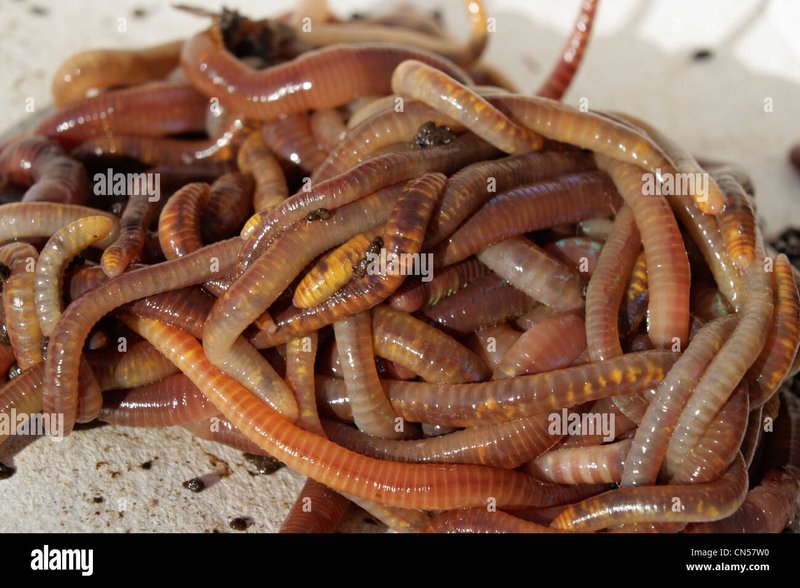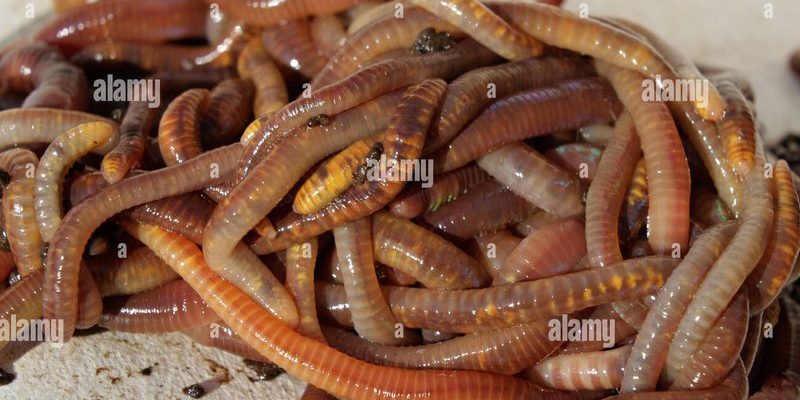
In this article, we’re diving into the fascinating interactions of *Eisenia hortensis* with other microfauna in its ecosystem. We’ll explore how this worm collaborates with bacteria, fungi, and other small soil organisms to create a balanced environment. By the end, you might find yourself appreciating those little squirmers a bit more—after all, they’re working hard to keep our gardens and natural habitats flourishing!
Understanding Eisenia Hortensis
To grasp how *Eisenia hortensis* interacts with other microfauna, it’s helpful to know a bit about the worm itself. These nightcrawlers are often found in moist, rich soil and are known for their impressive size—sometimes reaching up to 7 inches long! They’re not just scavengers; they’re also active in aerating the soil, which helps plants grow. But really, what makes them so special is their ability to transform organic matter into nutrient-rich compost, effectively recycling nutrients back into the ecosystem.
This worm’s diet primarily consists of decaying leaves and other organic debris. As they munch away, they break down this material, making it more accessible for bacteria and fungi. You can think of *Eisenia hortensis* as a kind of bridge between the dead plant matter and the tiny organisms that need it, helping to ensure that nutrients cycle efficiently through the ecosystem. This process is vital for sustaining soil health and fertility.
Another fascinating aspect of *Eisenia hortensis* is its effect on soil structure. By creating burrows in the earth, these worms help aerate the soil and improve drainage. This not only benefits plants but also creates a habitable environment for other microfauna. It’s like turning a compacted club into a lively dance floor—everything has more room to move and thrive!
The Role of Microfauna in Soil Ecosystems
Microfauna includes a variety of tiny organisms, such as bacteria, protozoa, and nematodes, that call the soil home. Each of these organisms has its own role to play, and together they create a bustling underground community. This interaction is crucial for soil health, much like different instruments harmonizing in a band to create beautiful music.
Bacteria, for example, are the primary decomposers of organic matter. They break down complex compounds into simpler substances, which then become accessible to plants. When *Eisenia hortensis* consumes decaying leaves, it works closely with bacteria that are already in the soil. As the worm digests this matter, it creates a nutrient-rich excrement, often referred to as worm castings. These castings are teeming with beneficial bacteria that enrich the soil and promote plant growth.
Another important player in the soil ecosystem is fungi. These organisms form networks in the soil, helping plants absorb water and nutrients. Worms like *Eisenia hortensis* contribute to the fungi’s effectiveness by breaking down organic material and increasing the availability of nutrients, which in turn supports the fungi’s growth and function. You might say that these tiny creatures are locked in a dance of cooperation, each benefiting from the other in a beautifully chaotic soil ecosystem.
Interactions with Bacteria
Now let’s focus on the relationship between *Eisenia hortensis* and bacteria. As the worm feasts on decomposing plant matter, it encourages bacterial growth, which helps decompose organic material even further. This is a great example of *mutualism*—where both parties benefit from the interaction.
Bacteria have a critical role in nutrient cycling. They break down organic compounds and help convert them into forms that plants can absorb. For instance, they can transform nitrogen from organic matter into ammonium, which plants can utilize. When *Eisenia hortensis* digests this organic matter, it doesn’t just produce worm castings; it also gives bacteria a rich environment to thrive in, resulting in a nutrient-dense ecosystem.
Moreover, the interaction between these worms and bacteria enhances soil structure. The action of the worm burrowing creates pathways in the soil, allowing bacteria to spread and colonize more effectively. This dynamic enhances the overall health of the soil, leading to better plant growth. You can think of it as a relay race—where the worm paves the way for bacteria to take the baton and continue the cycle of nutrient release.
Collaborations with Fungi
Fungi are another key component of the soil ecosystem, and their collaboration with *Eisenia hortensis* is remarkable. As worms break down organic matter, they also create conditions ideal for fungal growth. Fungi thrive in the nutrient-rich environment that results from the worm’s activities. This partnership is essential for enhancing plant health and soil fertility.
One fascinating aspect is mycorrhizal fungi, which form symbiotic relationships with plant roots. These fungi extend their networks into the soil, increasing a plant’s ability to absorb water and essential nutrients. When *Eisenia hortensis* digests organic material, it releases nutrients that promote the growth of mycorrhizal fungi. In return, plants benefit from improved nutrient access, showcasing yet another example of cooperation in nature.
In essence, this relationship illustrates how interconnected life is in the soil. Just like teammates working towards a goal in sports, *Eisenia hortensis* and fungi work together to create a more robust ecosystem. Without this interaction, plants might struggle to thrive, making the worm-fungi partnership vital for maintaining healthy soil.
Interactions with Other Soil Invertebrates
In addition to bacteria and fungi, *Eisenia hortensis* interacts with other soil invertebrates, such as nematodes and smaller arthropods. These tiny creatures contribute to the soil’s health and can also benefit from the presence of worms. Think of this as a community potluck—when everyone brings something to the table, the entire ecosystem thrives.
Nematodes, for example, are microscopic worms that can be both beneficial and harmful to plants. The beneficial types consume bacteria and fungi, contributing to nutrient cycling. When *Eisenia hortensis* aerates the soil and enriches it with nutrients, it creates an inviting environment for beneficial nematodes to flourish. This cooperation can lead to a more balanced ecosystem and healthier plants.
On the other hand, some arthropods, like springtails, also coexist with *Eisenia hortensis*. These tiny creatures feed on decaying organic matter and fungi, and they thrive in the rich environment created by the worm’s activities. Essentially, when one organism creates a rich habitat, it sets the stage for others to join in and benefit from the resources available.
When *Eisenia hortensis* interacts with these invertebrates, it amplifies the soil’s fertility and improves plant resilience. Each creature’s role may be small, but together, they form a community that can withstand challenges like pests or drought.
The Impact on Soil Health and Plant Growth
The interactions of *Eisenia hortensis* with various microfauna lead to overall improved soil health. Healthy soil is the foundation of a thriving ecosystem, providing plants with the necessary nutrients to grow strong and resilient. The worm’s ability to create a nutrient-rich environment and foster relationships with bacteria, fungi, and other invertebrates is crucial for sustaining healthy soil.
Moreover, when soil is well-aerated and full of diverse life forms, it enhances water retention and drainage. This balance can protect plants from drought and flooding—two extreme conditions that can otherwise devastate crops. It’s like creating a safety net for our green friends, ensuring they have a better chance of survival despite external pressures.
Additionally, with improved nutrient cycling, plants in healthy soil can produce more fruit, flowers, and foliage. As *Eisenia hortensis* and its partners improve the soil, the benefits extend to the entire ecosystem, creating a cycle of abundance that supports not only plants but also the animals and humans who rely on them.
In summary, the interactions of *Eisenia hortensis* with other microfauna are indispensable for maintaining robust soil health and promoting plant growth. This tiny worm isn’t just wriggling around mindlessly; it’s actively shaping its environment in ways that benefit a whole range of organisms.
As we’ve explored, *Eisenia hortensis* is far from just a humble worm. It plays a vital role in its ecosystem by interacting with bacteria, fungi, and other microfauna. These relationships are essential for nutrient cycling, soil health, and plant growth. When you think about the intricate web of life beneath our feet, it’s easy to appreciate the impact that a single species can have.
The efforts of *Eisenia hortensis* and its tiny companions remind us of the interconnectedness of all living things. In an age where we often overlook the small stuff, understanding these relationships helps highlight the importance of preserving healthy ecosystems. By nurturing the soil and the creatures that inhabit it, we can ensure a sustainable future for our gardens and natural environments.
So next time you see a worm in the ground, take a moment to appreciate the hard work it’s doing. It’s not just a squiggly creature; it’s a key player in the symphony of life that supports our planet.

